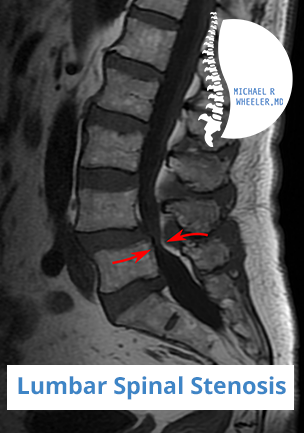What is Lumbar Spinal Stenosis?
Lumbar spinal stenosis is one of the more common spine conditions seen in a spine surgeon’s office. Lumbar spinal stenosis refers to narrowing of the spinal canal of the lumbar spine, the lower part of the back. Spinal stenosis causes the large group of nerves in the lumbar spine to be compressed or squeezed. It is generally a degenerative condition, meaning it occurs as the body goes through natural wear-and-tear processes. The combination of collapsed discs, enlarged/worn-out facet joints, and some thickening of the ligaments of the back of the spine (ligamentum flavum) cause circumferential narrowing (stenosis) of the lumbar spine. Sometimes, I describe stenosis acting like a boa constrictor squeezing the nerves circumferentially.
There are different locations for spinal stenosis. it can occur central or foraminal. Central stenosis occurs in the middle of the spinal canal where all the nerves are present. Foraminal stenosis occurs as the nerves are exiting the spine to the legs. Another analogy I use in clinic is the similarity to traffic jams. Central stenosis would be similar to a traffic jam on the highway, where all of the nerves are pinched. Foraminal stenosis would be if a traffic jam occurred on the exit lane, as the nerves are pinched on the way out. It is possible to have both central and foraminal stenosis at the same time.
 What symptoms does lumbar spinal stenosis cause?
What symptoms does lumbar spinal stenosis cause?
Stenosis can have a wide presentation in terms of symptoms and symptom severity. A textbook case of spinal stenosis would entail back and leg pain that is worse with activity. Meaning, as a person stands for prolonged periods of times or walks for prolonged periods of time, the symptoms felt will increase. In general, symptoms will improve or resolve with rest. Leaning forward can often relieve some of the back or leg pain. This occurs because when we lean forward, the spinal canal naturally opens up a little bit, which indirectly take some pressure off the nerves. A common location for lumbar spinal stenosis is the L4-5 level.
Although lumbar spinal stenosis can cause severe symptoms and affect quality of life, not everyone with spinal stenosis has symptoms. It is often found incidentally on imaging. There are many people who have spinal stenosis on their MRI who have minimal, or no symptoms. Just because the patient has spinal stenosis on imaging does not mean that it warrants treatment.
How is lumbar spinal stenosis diagnosed?
Spinal stenosis is diagnosed on MRI or a CT myelogram.
What is the treatment for lumbar spinal stenosis?
The management of spinal stenosis varies depending on the severity of the stenosis and the severity of symptoms. If symptoms are mildly bothersome, generally no treatment is warranted. If the patient has mild to moderate symptoms, usually management begins with conservative treatment including anti-inflammatory medications and an exercise program.
The next tier of treatment involves trial of pain management injections. Epidural steroid injections can be used to decrease the amount of inflammation of the nerves and therefore relieve symptoms. With injections, the degree of symptom relief and duration of symptom relief can be highly variable.
The only definitive treatment for spinal stenosis is surgical intervention, which will be some form of a decompression. By decompressing the spine, the pressure will be taken off the nerves. Exactly how this is done depends on the degree of stenosis, the location of the stenosis, and how many levels are involved.



